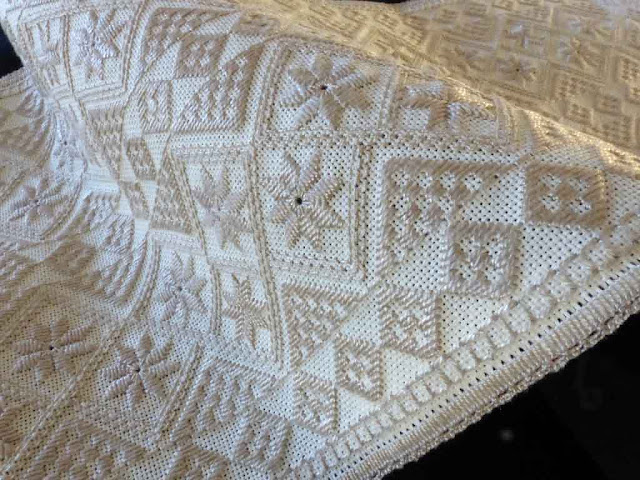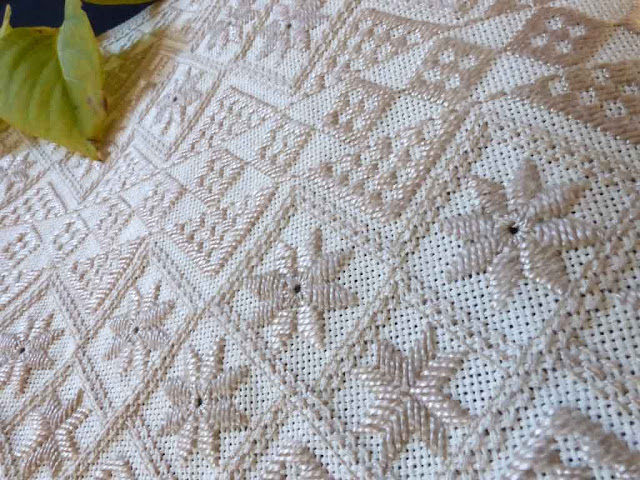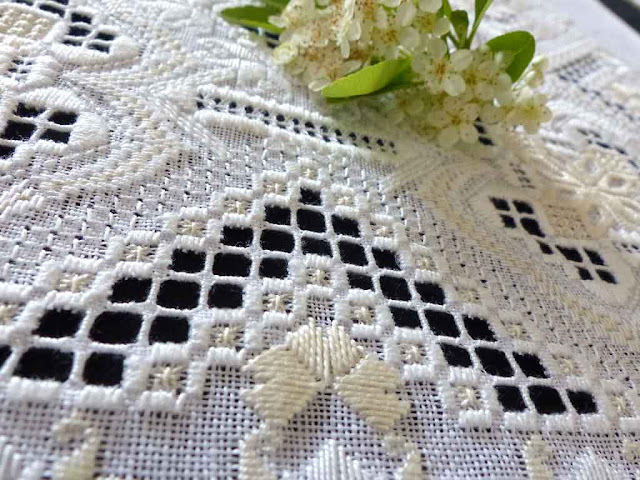mardi 14 décembre 2021
jeudi 25 novembre 2021
HEDEBO - Taellesyning
La région au sud-ouest de la capitale danoise Copenhague est connue comme le berceau de la broderie Hedebo. Vers 1700, plusieurs variations se sont développées dans cette technique de broderie, dont Taellesyning est la plus ancienne connue.
The area southwest of the Danish capital Copenhagen is known as the cradle of Hedebo embroidery. Around 1700 several variations developed in this embroidery technique, of which Taellesyning is the oldest known.
Het gebied ten zuidwesten van de Deense hoofdstad Kopenhagen staat bekend als de bakermat van het Hedebo-borduurwerk. Omstreeks 1700 ontwikkelden zich in deze borduurtechniek verschillende variaties, waarvan Taellesyning de oudst gekende is.
Taellesyning, ou 'couture comptée, était principalement appliquée sur le linge de maison, notamment sous forme de bandes brodées sur des draps, des serviettes, des chemises, etc. Comme avec tant d'anciennes techniques de broderie blanche, cette variation aussi présente une ressemblance frappante avec la broderie blanche en provenance d'autres régions européennes, comme le Hardanger (Norvège), la Marken (Pays-Bas), Friesland (Pays-Bas), le Punto Antico (Italie), etc.
Taellysining, or 'counted sewing', was mainly applied on household linen, especially in the form of embroidered bands on sheets, towels, shirts, etc. As with so many of the old whitework techniques, this variation also bears a striking resemblance with the whitework known to us from other European regions, such as Hardanger (Norway), Marken (Netherlands), Friesland (Netherlands), Punto Antico (Italy), etc.
Taellesyning, ofwel 'tellend naaien', werd hoofdzakelijk toegepast op huishoudlinnen, vooral onder de vorm van geborduurde stroken op lakens, handdoeken, hemden, enz. Zoals dit bij zoveel van de oude witwerktechnieken het geval is, vertoont ook deze variante een opvallende gelijkenis met het witwerk dat ons bekend is uit andere Europese streken, zoals Hadanger (Noorwegen), Marken (Nederland), Friesland (Nederland), Punto Antico (Italië), enz.
J'ai découvert la broderie Hedebo et sa technique à l'occasion de mon voyage aux Pays-Bas en 2018 (voir mon article Marker Ornament). Cette découverte m'avait tellement enthousiasmée, qu'une fois rentrée chez moi, avec l'aide de mon amie Lilian, j'ai immédiatement mis sur le métier un marquoir à bandes, que je suis (enfin!) sur le point de terminer. Il contient un aperçu de l'évolution de la broderie blanche dans la région de Hedebo. Donc, plus à ce sujet plus tard.
I discovered Hedebo embroidery and its technique on my trip to the Netherlands in 2018 (see my article Marker Ornament). This discovery left me so excited, that when I got home, with the help of my friend Lilian, I immediately set a bandsampler on foot, which I (finally!) am about to finish. It contains an overview of the evolution of whitework in the Hedebo region. So, more on that later.
Het Hedebo-borduurwerk en zijn techniek heb ik ontdekt ter gelegenheid van mijn reis naar Nederland in 2018 (zie mijn artikel Marker Ornament). Ik was zo enthousiast dat ik bij mijn thuiskomst, met de hulp van mijn vriendin Lilian, meteen een bandsampler op touw heb gezet, die ik nu (eindelijk!) aan het afwerken ben. Die bevat een overzicht van de evolutie van het witwerk uit het Hedebo-gebied. Later meer hierover dus.
J'ai tiré le modèle de cette broderie Taellesyning du livre 'Broderie Blanche Pas à Pas' d'Ayako Otsuka, édité par Les Editions de Saxe (ISBN 978-2-7565-3106-9).
Dans le livre, cette bande en Taellesyning est présentée comme une insertion sur un coussin. En ajustant un peu les motifs et en ajoutant une bordure, je l'ai transformée en chemin de table. Les points utilisés sont simples : des passés plats en forme d'étoiles et de pyramides. Et pour finir j'ai ajouté une fine bordure en dentelle à l'aiguille.
C'était de la broderie agréable, offrant un résultat qui plaît, en plus.
I found the model for this Taellesyning band in the book 'Broderie Blanche Pas à Pas' by Ayako Otsuka, published by Les Editions de Saxe (ISBN 978-2-7565-3106-9).
In the book the band is presented as an insertion on a cushion. By adjusting the motifs a bit and adding a border, I turned it into a runner. Only simple stitches are used : flat stitches in the shape of stars and pyramids. Finally I added a fine edge in needle lace.
This was pleasant embroidery, with a pleasing result.
Het model voor deze band in Taellesyning heb ik aangetroffen in het boek 'Broderie Blanche Pas à Pas' van Ayako Otsuka, uitgegeven door Les Editions de Saxe (ISBN 798-2-7565-3106-9).
In het boek wordt deze band voorgesteld als tussenzetsel op een kussen. Door de motieven wat aan te passen en een boord toe te voegen, heb ik er een loper van gemaakt. De gebruikte steken zijn eenvoudig : platsteken in de vorm van sterren en piramiden. Tenslotte heb ik het geheel nog van een fijne buitenrand in naaldkant voorzien.
Dit was aangenaam borduurwerk, met bovendien een bevallig resultaat.
Informations techniques
- toile : un joli morceau d'étamine 10 fils de DMC
- fil : Anchor Ritorto Fiorentino perlé Nos. 8 et 12, couleur 388
- dimensions : 47 x 20 cm
Technical information
- canvas : a nice piece of 25 count DMC etamine
- thread : Anchor Ritorto Fiorentino perlé Nos 8 and 12, colour 388
- dimensions : 47 x 20 cm
Technische gegevens
- stof : een mooi stuk 10 draads etamine van DMC
- garen : Anchor Ritorto Fiorentino perlé nrs. 8 en 12, kleur 388
- afmetingen : 47 x 20 cm
A celles et à ceux qui veulent en savoir plus sur la broderie Hedebo, je recommande fortement l'excellent article illustré de Claire de Pourtalès sur le site Le Temps de Broder.
To those who want to know more about Hedebo embroidery, I highly recommend the excellent illustrated article by Claire de Pourtalès on the site Le Temps de Broder.
Voor wie meer wil te weten komen over Hedebo-borduurwerk verwijs ik graag naar het uitstekend artikel met foto's van Claire de Pourtalès op de website Le Temps de Broder.
lundi 26 juillet 2021
HARDANGER - Relaxation
Voici un joli napperon en broderie hardanger, simple à réaliser, qui toutefois ne manque pas d'élégance raffinée.
This pretty hardanger doily, easy to make, nevertheless shows a fine elegance.
Dit aardig kleedje in hardanger, eenvoudig te borduren, straalt niettemin een fijne elegantie uit.
J'ai réalisé cet ouvrage d'après un modèle tiré de 'Hardanger Inspirations', une ancienne publication de Permin of Copenhagen.
I found the model of this embroidery in 'Hardanger Inspiration', an old publication of Permin of Copenhagen.
Het model van dit borduurwerk heb ik aangetroffen in 'Hardanger Inspiration', een oude uitgave van Permin of Copenhagen.
Cette broderie est simple à réaliser car, somme toute, il ne s'agit que de faire ressortir la structure du fil par l'application des points basiques du hardanger.
This embroidery is easy to make because in the end it is just a matter of showing up well the structure of the thread by applying the basic hardanger stitches.
Dit borduurwerk is gemakkelijk te maken, want uiteindelijk is het niets meer dan de structuur van het garen duidelijk te laten uitkomen door toepassing van de basissteken van hardanger.
C'est de la broderie très agréable à faire qui, de plus, vous apporte la quiétude et la relaxation précieuses dans l'ambiance agitée du Covid-19 dans laquelle nous nous trouvons actuellement.
It is very pleasant embroidery that, moreover, brings some precious peace and relaxation in the nervous Covid-19 atmosphere we live in at present.
Het is zeer aangenaam borduurwerk dat bovendien wat kostbare rust en relax brengt in de gespannen Covid-19 atmosfeer waarin we ons thans bevinden.
Informatins techniques
- J'ai brodé mon ouvrage 'Relaxation' sur du lin Etruria blanc 14 fils de Sotema
- Fil : Venne Colcoton 34/2 et 34/3 couleur 7-7001, et Venne Colcoton 70/2 couleur 7-7001
- Dimensions de l'ouvrage terminé : 23 x 23 cm
Technical information
- I embroidered my 'Relaxation' on 36 count white Etruria linen from Sotema
- Thread : Venne Colcoton 34/2 and 34/3 colour 7-7001, and Venne Colcoton 70/2 colour 7-7001
- Dimensions of the finished work : 23 x 23 cm
Technische gegevens
- Ik heb mijn 'Relaxation' geborduurd op 14 draads wit Etruria linnen van Sotema
- Gebruikt garen : Venne Colcoton 34/2 en 34/3 kleur 7-7001, en Venne Colcoton 70/2 kleur 7-7001
- Afmetingen van het afgewerkt borduurwerk : 23 x 23 cm
jeudi 24 juin 2021
HARDANGER - Ivory Blush
Ce magnifique modèle hardanger, conçu en 2010 par Judy Dixon, a immédiatement attiré mon attention et figurait depuis un certain temps sur ma liste de choses à faire.
This magnificent hardanger pattern, designed in 2010 by Judy Dixon, immediately caught my attention and had been on my to-do list for quite some time.
Dit magnifiek hardangermodel, in 2010 ontworpen door Judy Dixon, had meteen mijn aandacht getrokken en stond al een hele tijd op mijn to-do lijst.
Je n'ai pas suivi la créatrice du Ivory Blush dans son choix de couleurs et de fil, mais j'ai puisé dans ma propre réserve. C'était au début du printemps quand j'ai commencé à broder cet ouvrage, d'où mon penchant pour le blanc et le jaune clair.
I did not follow Ivory Blush's designer in her choice of colours and thread, but drew from my own stock. It was early spring when I started this embroidery, hence the white and light yellow.
Ik heb de ontwerpster van Ivory Blush niet gevolgd in haar kleuren- en garenkeuze, maar uit mijn eigen voorraad geput. Het was prille lente toen ik dit kleed begon te borduren, vandaar wellicht het wit en lichtgeel.
Ivory Blush est assez facile à broder et, en outre, je trouve le résultat particulièrement satisfaisant.
Ivory Blush is quite easy to embroider and besides, I find the result very satisfying.
Ivory Blush is vrij makkelijk te borduren en ik vind het resultaat bovendien bijzonder bevredigend.
Informations techniques
- toile : lin 12 fils de Permin of Copenhagen : excellent lin, ferme et régulier
- fil : Ritorto Fiorentino de Anchor, épaisseurs n° 8 et 12, couleurs 1 (blanc) et 926 (entre écru et jaune clair)
- dimensions de l'ouvrage : 43 x 43 cm
Technical information
- fabric : 30 count linen from Permin of Copenhagen : excellent linen, firm and regular
- thread : Ritorto Fiorentino from Anchor, No 8 and 12, colours 1 (white) and 926 (between ecru and light yellow)
- dimensions of the embroidery : 43 x 43 cm
Technische gegevens
- borduurlinnen : 12 draads linnen van Permin of Copenhagen : excellent linnen, stevig en regelmatig
- garen : Ritorto Fiorentino van Anchor in diktes nr. 8 en 12, kleuren 1 (wit) en 926 (tussen ecru en lichtgeel)
- afmetingen van het borduurwerk : 43 x 43 cm
Inscription à :
Articles (Atom)
































































